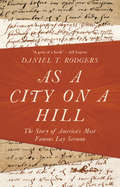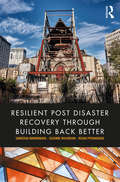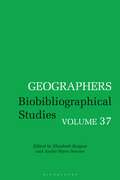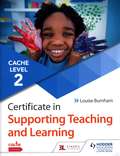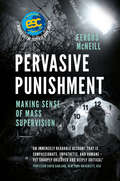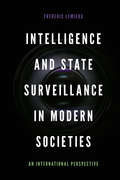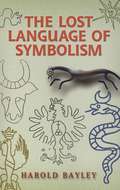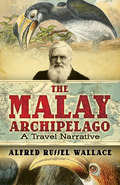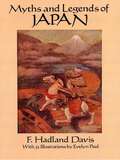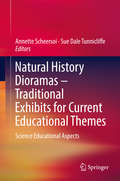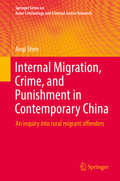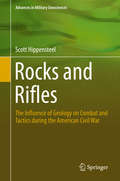- Table View
- List View
As a City on a Hill: The Story of America's Most Famous Lay Sermon
by Daniel T. RodgersHow an obscure Puritan sermon came to be seen as a founding document of American identity and exceptionalism“For we must consider that we shall be as a city upon a hill,” John Winthrop warned his fellow Puritans at New England’s founding in 1630. More than three centuries later, Ronald Reagan remade that passage into a timeless celebration of American promise. How were Winthrop’s long-forgotten words reinvented as a central statement of American identity and exceptionalism? In As a City on a Hill, leading American intellectual historian Daniel Rodgers tells the surprising story of one of the most celebrated documents in the canon of the American idea. In doing so, he brings to life the ideas Winthrop’s text carried in its own time and the sharply different yearnings that have been attributed to it since.As a City on a Hill shows how much more malleable, more saturated with vulnerability, and less distinctly American Winthrop’s “Model of Christian Charity” was than the document that twentieth-century Americans invented. Across almost four centuries, Rodgers traces striking shifts in the meaning of Winthrop’s words—from Winthrop’s own anxious reckoning with the scrutiny of the world, through Abraham Lincoln’s haunting reference to this “almost chosen people,” to the “city on a hill” that African Americans hoped to construct in Liberia, to the era of Donald Trump.As a City on a Hill reveals the circuitous, unexpected ways Winthrop’s words came to lodge in American consciousness. At the same time, the book offers a probing reflection on how nationalism encourages the invention of “timeless” texts to straighten out the crooked realities of the past.
As a City on a Hill: The Story of America's Most Famous Lay Sermon
by Daniel T. RodgersHow an obscure Puritan sermon came to be seen as a founding document of American identity and exceptionalism“For we must consider that we shall be as a city upon a hill,” John Winthrop warned his fellow Puritans at New England’s founding in 1630. More than three centuries later, Ronald Reagan remade that passage into a timeless celebration of American promise. How were Winthrop’s long-forgotten words reinvented as a central statement of American identity and exceptionalism? In As a City on a Hill, leading American intellectual historian Daniel Rodgers tells the surprising story of one of the most celebrated documents in the canon of the American idea. In doing so, he brings to life the ideas Winthrop’s text carried in its own time and the sharply different yearnings that have been attributed to it since.As a City on a Hill shows how much more malleable, more saturated with vulnerability, and less distinctly American Winthrop’s “Model of Christian Charity” was than the document that twentieth-century Americans invented. Across almost four centuries, Rodgers traces striking shifts in the meaning of Winthrop’s words—from Winthrop’s own anxious reckoning with the scrutiny of the world, through Abraham Lincoln’s haunting reference to this “almost chosen people,” to the “city on a hill” that African Americans hoped to construct in Liberia, to the era of Donald Trump.As a City on a Hill reveals the circuitous, unexpected ways Winthrop’s words came to lodge in American consciousness. At the same time, the book offers a probing reflection on how nationalism encourages the invention of “timeless” texts to straighten out the crooked realities of the past.
The First Marx: A Philosophical Introduction
by Peter Lamb Douglas BurnhamMarx's early work is well known and widely available, but it usually interpreted as at best a kind of stepping-stone to the Marx of Capital. This book offers something completely different; it reconstructs, from his first writings spanning from 1835 to 1846, a coherent and well-rounded political philosophy. The influence of Engels upon the development of that philosophy is discussed. This, it is argued, was a philosophy that Marx could have presented had he put the ideas together, as he hinted was his eventual intention. Had he done so, this first Marx would have made an even greater contribution to social and political philosophy than is generally acknowledged today.Arguments regarding revolutionary change, contradiction and other topics such as production, alienation and emancipation contribute to a powerful analysis in the early works of Marx, one which is worthy of discussion on its own merits. This analysis is distributed among a range of books, papers, letters and other writings, and is gathered here for the first time. Marx's work of the period was driven by his commitment to emancipation. Moreover, as is discussed in the conclusion to this book, his emancipatory philosophy continues to have resonance today. This new book presents Marx in a unique, new light and will be indispensable reading for all studying and following his work.
Resilient Post Disaster Recovery through Building Back Better
by Sandeeka Mannakkara Suzanne Wilkinson Regan Potangaroa"Building Back Better" (BBB) has been a popular slogan in disaster recovery efforts around the world, including the 2004 Indian Ocean Tsunami, the 2009 Samoan Tsunami, the 2010 Haiti Earthquake and the 2011 Great East Japan Earthquake. BBB has recently been identified as one of four priorities of action for disaster risk reduction globally in the next 15 years by the United Nations Sendai Framework. However, there has consistently been a mismatch and confusion in the interpretation of the phrase and what BBB encapsulates which has made proper implementation difficult and unsuccessful at times. This book explains the concept of "Building Back Better" as an innovative holistic approach to rebuilding a community following a disaster event in order to develop resilience. It begins by exploring the background, development and definitions of BBB. The theory behind establishing BBB as a holistic concept is explained and the internationally recognised BBB Framework developed by the authors is introduced and described. Each of the components of the Framework are explained in detail with findings from international research and case studies from the US, Haiti, Indonesia, Samoa, Sri Lanka, Vanuatu, Gaza, China, Australia, UK and New Zealand, providing practical recommendations for implementation in recovery projects. There is a focus on the translation of BBB theory into practice to assist implementers to use the BBB Framework and BBB Indicators introduced in this book as an effective tool to plan and implement disaster recovery projects. This publication can be used as a handbook by government, non-governmental and private industry practitioners to prepare for and implement post disaster recovery projects that benefit and strengthen local communities and as a core text on international Disaster and Energy Management courses.
Conflict and Contest in Nietzsche's Philosophy
by Herman Siemens James PearsonWhile Nietzsche's works and ideas are relevant across the many branches of philosophy, the themes of contest and conflict have been mostly overlooked. Conflict and Contest in Nietzsche's Philosophy redresses this situation, arguing for the importance of these issues throughout Nietzsche's work.The volume has three key lines of inquiry: Nietzsche's ontology of conflict; Nietzsche's conception of the agon; and Nietzsche's warrior-philosophy. Under these three umbrellas is a collection of insightful and provocative essays considering, among other topics, Nietzsche's understanding of resistance; his engagement with classical thinkers alongside his contemporaries, including Jacob Burckhardt; his views on language, metaphor and aphorism; and war, revolt and terror. In bringing together such topics, Conflict and Contest in Nietzsche's Philosophy seeks to correct the one-sided tendencies within the existing literature to read simply 'hard' and 'soft' analyses of conflict.Written by scholars across the Anglophone and the European traditions, within and beyond philosophy, this collection emphasises the entire problematic of conflict in Nietzsche's thought and its relation to his philosophical and literary practice.
Geographers: Biobibliographical Studies, Volume 37 (Geographers)
by Elizabeth Baigent André Reyes NovaesGeographers: Biobibliographical Studies, Volume 37 explores the concept of distinction in geography. Through the lives of six geographers working in Brazil and Réunion, it investigates what distinction consists of, how we identify and celebrate it and how it relates to quotidian practices in the discipline.The volume highlights the continuing importance of biography and the International Geographical Union in recording and assessing distinction. It also considers the relevance of personal networks for the circulation and translation of distinguished geographical knowledge, and how this knowledge can underpin applied projects and critical appraisal of geographical scholarship, both at a national and sub-national level. Gendered notions of distinction are also addressed, particularly through June Sheppard, who found limited recognition for her work as a result of gendered expectations within the discipline and society at large.By reflecting on how we locate distinguished geographers and tell their histories, Geographers: Biobibliographical Studies, Volume 37 makes an important contribution to fostering less canonical work in historical geography.
Being Muslim the Bosnian Way: Identity and Community in a Central Bosnian Village (Princeton Studies in Muslim Politics #3)
by Tone Bringa"I have been able to follow a Bosnian community over a period of six years, during which it has undergone dramatic changes. In the late 1980s people were working hard against economic crisis. In 1990 they were full of optimism for the future. In January 1993 the village was in fear, surrounded by war on all sides. In April 1993 it was attacked by Croat forces. In October 1993 none of the Muslims in the village remained. They had either fled, been placed in detention camps, or been killed."Thus begins Tone Bringa's moving ethnographic account of Bosnian Muslims' lives in a rural village located near Sarajevo. Although they represent a majority of the population in the Republic of Bosnia and Herzegovina, Bosnian Muslims are still members of a minority culture in the region that was once Yugoslavia. The question of ethno- national identity has become paramount in this society, and the author focuses on religion as the defining characteristic of identity. Bringa pays particular attention to the roles that women play in defining Muslim identities, and she examines the importance of the household as a Muslim identity sphere. In so doing, she illuminates larger issues of what constitutes "nationality."This is a gripping and heartfelt account of a community that has been torn apart by ethno-political conflict. It will attract readers of all backgrounds who want to learn more about one of the most intractable wars of the late twentieth century and the people who have been so tragically affected.
Making waves behind bars: The Prison Radio Association
by Charlotte BedfordRadio produced and broadcast behind prison walls is redefining traditional meanings of ‘public service broadcasting’ and disrupting traditional power structures within the prison system. Focusing on one of the most interesting developments in UK prisons over the past 10 years, this book examines the early history of the Prison Radio Association and the formation of the first national radio station for prisoners. Highlighting the enduring importance of social values in broadcasting this book shows how radio can be used as a powerful force for social change. It will be of interest to those involved in media, criminal justice and social activism.
Making waves behind bars: The Prison Radio Association
by Charlotte BedfordRadio produced and broadcast behind prison walls is redefining traditional meanings of ‘public service broadcasting’ and disrupting traditional power structures within the prison system. Focusing on one of the most interesting developments in UK prisons over the past 10 years, this book examines the early history of the Prison Radio Association and the formation of the first national radio station for prisoners. Highlighting the enduring importance of social values in broadcasting this book shows how radio can be used as a powerful force for social change. It will be of interest to those involved in media, criminal justice and social activism.
Prison suicide: What happens afterwards?
by Philippa TomczakAlthough prison suicide is a global problem, there is little knowledge about the investigations occurring after prison suicides. Addressing this gap, this book provides the first detailed case study of the investigations that follow prison suicides: using England and Wales. Despite the large range of institutions that monitor English and Welsh prisons, suicides reached a record high in 2016, with the rate having doubled since 2012. These deaths represent the sharp end of a continuum of suffering, self-harm, despair and distress within prisons, which affects prisoners, their families and prison staff. This book details and critiques the lengthy and expensive police, ombudsman and coroner investigations that follow prison suicides. Drawing on extensive document analysis, including analysis of over 100 Prison and Probation Ombudsman fatal incident investigations, and original semi-structured interviews with stakeholders undertaken between 2016-2017, this book provides a novel analysis of prison oversight.
Counselling Adolescents: The Proactive Approach for Young People
by Rebecca Yin Foo David Geldard Kathryn GeldardThis is the definitive guide to counselling adolescents. Now in its fourth edition, this bestseller has introduced thousands of trainees and practitioners to the theory, principals, skills and techniques of proactively counselling this client group. New to the fourth edition: - A new chapter on the contemporary context of adolescence, exploring the challenges, opportunities and influences facing young people today. - A new chapter on the use of technology when counselling young people - Useful links to relevant online resources at the end of each chapter - Updates to all chapters reflecting more recent understanding, research and literature - Additional case studies to help trainees apply theory and strategies to practice A multi-disciplinary book which recognises that a diversity of needs requires a diversity of approaches and skills, it uses case studies and examples to demonstrate this in a variety of settings. It is essential reading for trainees and practitioners in counselling, social work, the allied health professions and education.
CACHE Level 3 Child Care and Education (Early Years Educator)
by Carolyn Meggitt Tina BruceHelp your students master the knowledge and skills they need for the new CACHE Level 3 Award, Certificate and Diploma in Childcare & Education (Early Years Educator)Written by experts Carolyn Meggitt and Tina Bruce, this is the only resource for the Level 3 Diploma in Childcare & Education (EYE) endorsed by CACHE. The approachable writing style makes learning key concepts both easy and enjoyable for all learners, and all aspects of the qualification are covered and linked to specific learning outcomes. This book will support your students through their assessment and the start of their careers.- Communicates all the requirements of the new qualification fully with clearly stated learningoutcomes and key terms- Shows how concepts are applied in real settings with numerous case studies- 'In Practice' boxes give students the opportunity to check and reflect on their understanding- Includes activity boxes linked to assessment criteria to prepare learners for examinationsand assessment
CACHE Level 2 Certificate in Supporting Teaching and Learning
by Louise BurnhamBe inspired to enhance classroom learning with this textbook, by highly respected and experienced author Louise Burnham.-Build your learning support skills with guidance tailored to the extensive new CACHE qualification due to launch in January 2018-Gain confidence in your role with practical advice and full explanations from best-selling author in STL , Louise Burnham -Translate theory into practice with Tips for Best Practice and Case Studies for challenging topics such as Behaviour Management-Strengthen your understanding of theory and practice, with comprehensive information linked clearly to assessment criteria-Find all the information you need with the colourful, clear design and appropriate language throughout the book -Make the most of your training with the Stretch and Challenge feature-Engage in debate on important STL topics with Classroom Discussion suggestions
Pervasive Punishment: Making Sense of Mass Supervision
by Fergus McNeillDespite its dramatic proliferation and diversification in recent decades, supervisory forms of punishment in the community (like probation, parole and unpaid work) have been largely invisible in scholarly and public discussion of criminal justice and its development in late-modern societies. The long-standing pre-occupation with the prison, and more recent concerns about 'mass incarceration' have allowed the emergence of 'mass supervision' to remain in the shadows. Pervasive Punishment insists that we remedy this neglect and exemplifies how we can do so. Drawing on thirty years of personal, practice and research experiences, it offers a compelling and rich account of the scale and social distribution of mass supervision, of the processes by which it has been legitimated, and of how it is experienced by those subject to it. Its innovative approach invites readers to look at, listen to and imagine punishment beyond the prison, through the use of innovative and creative methods including photography, song-writing and story-telling to explore and to represent 'mass supervision'. By so doing, this book offers new insights into how and why combining social science and creative practice can help develop a different kind of democratic dialogue about contentious social issues like crime and punishment. Though focused on the UK and the USA, the methods used in and analysis developed in this book will be of interest to scholars, students and practitioners elsewhere.
Pervasive Punishment: Making Sense of Mass Supervision
by Fergus McNeillDespite its dramatic proliferation and diversification in recent decades, supervisory forms of punishment in the community (like probation, parole and unpaid work) have been largely invisible in scholarly and public discussion of criminal justice and its development in late-modern societies. The long-standing pre-occupation with the prison, and more recent concerns about 'mass incarceration' have allowed the emergence of 'mass supervision' to remain in the shadows. Pervasive Punishment insists that we remedy this neglect and exemplifies how we can do so. Drawing on thirty years of personal, practice and research experiences, it offers a compelling and rich account of the scale and social distribution of mass supervision, of the processes by which it has been legitimated, and of how it is experienced by those subject to it. Its innovative approach invites readers to look at, listen to and imagine punishment beyond the prison, through the use of innovative and creative methods including photography, song-writing and story-telling to explore and to represent 'mass supervision'. By so doing, this book offers new insights into how and why combining social science and creative practice can help develop a different kind of democratic dialogue about contentious social issues like crime and punishment. Though focused on the UK and the USA, the methods used in and analysis developed in this book will be of interest to scholars, students and practitioners elsewhere.
Intelligence and State Surveillance in Modern Societies: An International Perspective
by Frederic LemieuxOften described as ‘two solitudes’, law enforcement and national security intelligence agencies engage in intensive collaboration to address both international and domestic threats. This situation has blurred the lines between interior and exterior security; common crime and crime against the state; civil liberties, privacy, and intrusive surveillance activities; strategic national security intelligence and operational military intelligence requirements. National and local law enforcement agencies now conduct intelligence operations against international terrorist groups while national security intelligence organizations infiltrate organized crime and intercept citizens’ communications on a daily basis. Other important trends are reshaping the state’s surveillance and intelligence apparatus in modern societies, including the use of cyberspace for information collection, the expansion of surveillance technology penetrating citizens’ everyday life, and the rise of the private sector as a primary surveillance facilitator or third party in national security intelligence collection and dissemination. This book will be of interest to those seeking to understand the intelligence environment in modern times, providing a broad understanding of current and emerging issues related to intelligence activities and offers a unique way of thinking about contemporary challenges in this field.
Intelligence and State Surveillance in Modern Societies: An International Perspective
by Frederic LemieuxOften described as ‘two solitudes’, law enforcement and national security intelligence agencies engage in intensive collaboration to address both international and domestic threats. This situation has blurred the lines between interior and exterior security; common crime and crime against the state; civil liberties, privacy, and intrusive surveillance activities; strategic national security intelligence and operational military intelligence requirements. National and local law enforcement agencies now conduct intelligence operations against international terrorist groups while national security intelligence organizations infiltrate organized crime and intercept citizens’ communications on a daily basis. Other important trends are reshaping the state’s surveillance and intelligence apparatus in modern societies, including the use of cyberspace for information collection, the expansion of surveillance technology penetrating citizens’ everyday life, and the rise of the private sector as a primary surveillance facilitator or third party in national security intelligence collection and dissemination. This book will be of interest to those seeking to understand the intelligence environment in modern times, providing a broad understanding of current and emerging issues related to intelligence activities and offers a unique way of thinking about contemporary challenges in this field.
The Lost Language of Symbolism
by Harold BayleyThere's always a story behind the story, but the keenest observers have to break through the surface to reach it. This remarkable book reveals the hidden meaning behind familiar images and words, from the origins of Santa Claus and the meaning of Cinderella's name to the metaphoric significance of the unicorn and the fleur-de-lys.A prominent authority on symbols, author Harold Bayley spent years gathering and compiling the contents of this volume. Mythology, folklore, religious texts, and fairy tales from around the world constitute his primary sources. Bayley also draws upon the secret traditions of ancient cultures and medieval mystical sects to deconstruct the symbols embedded in watermarks and printers' emblems. Most of these images have lost their earliest significance and now serve strictly commercial purposes; Bayley explains their original meanings, and he cross-references similarities between symbols and stories across the globe to illuminate their evolving cultural significance. More than 1,400 illustrations enhance this classic work, which features an index for ease of reference.
The Malay Archipelago: A Travel Narrative
by Alfred Russel WallaceWritten by a famed 19th-century scientist who laid the groundwork for much of modern biology, this influential work remains one of the great classics of natural history and travel. Detailing his eight-year exploration of the Malay Archipelago, Wallace offers observations of the native people of the island groupings, the abundant and strange animals and insects, and more.
Manners, Customs, and Conditions of the North American Indians, Volume I: With Letters And Notes Written During Eight Years Of Travel And Ad (Native American #1)
by George CatlinVolume 1 of the classic account of life among Plains Indians includes fascinating information on ceremonies, rituals, the hunt, warfare, and much more. Total in set: 312 plates.
Maori Tattooing
by H. G. RobleyOriginally published in 1896, this classic of ethnography was assembled by a skilled illustrator who first encountered Maori tattoo art during his military service in New Zealand. Maori tattooing (moko) consists of a complex design of marks, made in ink and incised into the skin, that communicate the bearer's genealogy, tribal affiliation, and spirituality. This well-illustrated volume summarizes all previous accounts of moko and encompasses many of Robley's own observations. He relates how moko first became known to Europeans and discusses the distinctions between men and women's moko, patterns and designs, moko in legend and song, and the practice of mokomokai: the preservation of the heads of Maori ancestors. Features 180 black-and-white illustrations.
Myths and Legends of Japan
by F. Hadland DavisThe most popular myths and legends of Japanese culture are charmingly retold in English in this handsomely illustrated book. Here are myths of gods, heroes and warriors; legends of Buddha, and of the goddess Benten and the god Daikoku; tales of the sea and of Mount Fuji; accounts of superstitions and supernatural beings; observations on the spiritual properties of fans, flowers, dolls and butterflies and much more.The collection begins with the early myths of Japan, which the author describes as "quaint, beautiful, quasi-humorous." These are followed by legends celebrating early heroes and warriors, and the earliest examples of the Japanese romance, "The Bamboo-Cutter and the Moon-Maiden." Many of the legends that follow reflect a poetic love of beauty and of nature. But as the author points out, "there is plenty of crude realism in Japanese legend. We are repelled by the Thunder God's favorite repast, amazed by the magical power of foxes and cats; and the story of 'Hōïchi-the-Earless' and of the corpse-eating priest afford striking examples of the combination of the weird and the horrible."Thirty-two full-page illustrations offer compelling images of Buddha and the Dragon; A Kakemono Ghost; The Jelly-Fish and the Monkey; The Firefly Battle; Tokoyo and the Sea Serpent; Sengen, the Goddess of Mount Fuji; and other subjects of these timeless myths. In addition, the author has included several invaluable appendixes that offer a helpful note on Japanese poetry, a listing of gods and goddesses, a genealogy of The Age of the Gods, and an index of poetical quotations.
Natural History Dioramas – Traditional Exhibits for Current Educational Themes: Science Educational Aspects
by Annette Scheersoi Sue Dale TunnicliffeThis book presents the history of natural history dioramas in museums, their building and science learning aspects, as well as current developments and their place in the visitor experience. From the early 1900s, with the passage of time and changes in cultural norms in societies, this genre of exhibits evolved in response to the changes in entertainment, expectations and expressed needs of museum visitors. The challenge has always been to provide meaningful, relevant experiences to visitors, and this is still the aim today. Dioramas are also increasingly valued as learning tools. Contributions in this book specifically focus on their educational potential. In practice, dioramas are used by a wide range of educational practitioners to assist learners in developing and understanding specific concepts, such as climate change, evolution or or conservation issues. In this learning process, dioramas not only contribute to scientific understanding and cultural awareness, but also reconnect wide audiences to the natural world and thereby contribute to the well-being of societies.In the simultaneously published book: “Natural History Dioramas – Traditional Exhibits for Current Educational Themes, Socio-cultural Aspects” the editors focus on socio-cultural issues and the potential of using dioramas to engage various audiences with – and in – contemporary debates and big issues, which society and the natural environment are facing.
Internal Migration, Crime, and Punishment in Contemporary China: An inquiry into rural migrant offenders (Springer Series on Asian Criminology and Criminal Justice Research)
by Anqi ShenThis work investigates inequality and social exclusion in contemporary Chinese society, specifically in the context of urbanization, migration and crime. Economic reforms started in the late 1970s (post-Mao) fuelled a trend of urbanization and mass migration within China, largely from rural areas to more economically developed urban regions. With this migration, came new challenges in a rapidly changing society. Researchers have extensively studied the rural-to-urban human movement, social changes, inequality and its impact on individuals and society as a whole. This volume provides a new perspective on this issue. It forges a link between internal migration, inequality, social exclusion and crime in the context of China, through qualitative research into the impact of this phenomenon on individuals’ lives. Using a series of case studies drawn from interviews with inmates – men and women – in a large Chinese prison, it focuses on migrant offenders’ subjective experiences, and analyses issues from the rarely-heard perspectives of migrant lawbreakers themselves. The research demonstrates how factors – including: the hukou system, rural-urban, class and gender inequalities, prejudices against rural migrants, and other structural problems – often lead to migrant offending. The author argues that to mitigate the effects of criminalisation, the root causes of these problems should be examined, emphasizing radical reforms to the hukou policy, cultural change in urban society to welcome newcomers, positive programs to integrate migrant workers into urban societies and improve their opportunities, rather than inflicting harsher penalties or reducing migration. While the research is based in China, it has clear implications for other regions of the world, which are experiencing similar tensions related to national and international migration. This work will be of interest to researchers in criminology and criminal justice, particularly with an interest in Asia, as well as those in related fields such as sociology, law and social justice.
Rocks and Rifles: The Influence of Geology on Combat and Tactics during the American Civil War (Advances in Military Geosciences)
by Scott HippensteelThis book discusses the relationship between geology and fighting during the American Civil War. Terrain was largely determined by the underlying rocks and how the rocks weathered. This book explores the difference in rock type between multiple battlegrounds and how these rocks influenced the combat, tactics, and strategies employed by the soldiers and their commanding officers at different scales.
